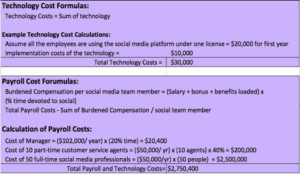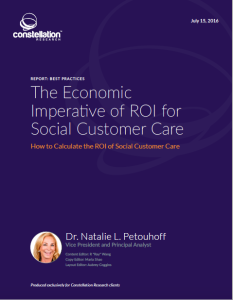The phrase “customer service is the new marketing” has gained popularity with brands realizing that poor customer service takes current, and even potential customers, out of the marketing funnel. Why? If a customer doesn’t get the help she needs, she often will not remain loyal – or worse, she will take to social media and tarnish the brand. Think about it. If a consumer’s flight gets delayed or she receives terrible food brought to the table, she might post on Twitter, Facebook, Instagram, Snapchat, and Yelp within minutes of the incident. From one mistake, a company’s reputation can be smeared all over the internet. The report goes into a lot of detail so it’s clear how to calculate the ROI of social customer service:
Many brands have experienced incidents where not taking care of an issue turned into a social media nightmare. These include brands like Domino’s Pizza[i], the Red Cross[ii], McDonald’s[iii], and Cisco and extends to people’s personal brands such as comedian Gilbert Gottfried[iv] and hockey player Tyler Sequin.[v]
Customer care extends far beyond the traditional call center. Every touch point or interaction with the company (or even content about the company) can affect the customer’s satisfaction and loyalty to the brand. While it’s not always a positive experience, brands need to hear opinions expressed online to enable them to create the necessary corrections, drive strategy, and improve operations for making great customer experiences.
To gain buy-in for this type of interaction in a social customer service program, executives need to show senior leaders a viable business case. Once everyone is on board, it’s time to create some baseline metrics and goals and then determine what the ROI needs to be based on the program qualifications being set in place. The components of a business case include:
- Goals and objectives for the social customer care initiative
- A strategy to meet the social customer care goals and objectives
- Metrics/Key Performance Indicators (KPIs) to measure the goals and objectives
- The business results (cost savings or revenue generation) or the return on investment (ROI) for the social customer care initiative.
How to Calculate Social Customer Care ROI
Constellation often hears comments such as “the ROI of social media can’t be calculated because there are too many unknowns” or “don’t worry about the ROI – social media is very tactical – just start doing it – get a Twitter handle, a Facebook page, a Pinterest account.” Some people may quote metrics and/or KPIs, but few know how to convert them into ROI.
An ROI calculation offers a way to put the business strategy and metrics into a formula to show, in numbers, how the strategy is, for instance, increasing revenue or decreasing costs. ROI calculations can also provide perspective on the potential strengths or weaknesses of the strategy. Examples in this report will show how correctly calculating ROI will help in the evaluation and improvement of your strategies. The formula to calculate ROI is:
Return on Investment = (Gains from Investment) – (Costs of Investment) x 100
Costs of Investment
Calculating the ROI of social media involves three variables:
- Traditional customer care business metrics
- Social media metrics
- Changes to traditional business processes and metrics when social media is applied to a business initiative.
Here’s an Example: Social Customer Care Increases Revenue and Customer Lifetime Value
An international airline that services over 280 destinations worldwide uses a social media tool for monitoring all its social channels, engaging back with its online communities, doing in-depth reporting, and tracking KPI metrics and agent performance. Most importantly, the platform the airline uses supports its global consumer base, enabling the airline to monitor the 30,000 social mentions received in more than nine languages each month.
A company’s revenue is based on the number of customers and the average purchase value in a period of time. When companies use a social media platform, they can increase their revenue from existing customers. By engaging and listening, they can retain them as customers and increase the amount and frequency of purchases over a longer period of time. When the company is truly listening and integrating the feedback, like the airline above, it will be able to meet the needs of the customer and increase not only the amount that the customer spends, but also the number of years the customer spends with that company.
Calculating Costs
To calculate costs, we look at the cost of the technology and implementation (see Figure 1). Then we also look at the cost of the employees or customer service professionals providing the social customer care. The payroll costs include the expenses of a manager part-time as well as the cost of 10 part-time customer service agents with 40 percent of their time spent on social customer care and 50 full-time customer care social media professionals. The total of the costs for both technology ($30,000) and payroll ($2,720,400) is $2,750,400.
Figure 1. Airline Example of Customer Social Media Cost Calculation
Calculating Gains
The benefit calculation is created by determining the extra revenue generated from more loyal customers who spend more with the airline. The annual number of customers or passengers per year is 22,000,000 with an average spend per customer of $250. With the increased responsiveness and better social customer service, we estimate that 10 percent of the customers will spend 10 percent more per year. The ROI is calculated by taking the $55,000,000 minus $2,750,400 x 100 divided by $2,750,400. This total increase in revenue is approximately $55,000,000 (see Figure 2), and the ROI is 1899 percent. This means that the airline made $18.99 for every dollar that it invested in social customer care.
Figure 2. Airline Example of Customer Social Media Gain Calculation
In the report, we go over many different examples of how companies have calculated ROI. Though there are nearly dozens of ways that social adds to the value of not only Customer Service, Marketing, Product Innovation, Supply Chain, ERP as well as Internal Operations – like acquiring recruiting and retaining top talent. If you want more help on these types of calculations, we are here to help!
@DrNatalie, VP and Principal Analyst, Constellation Research
Covering Customer-Facing Applications and how Social, IOT, Machine Learning and AI Transform Customer Experience
[i] “Managing Bad News in Social Media: A Case Study on Domino’s Pizza Crisis”, Jaram Park, Meeyoung Cha, Hoh Kim, Jaeseung Jeong, Graduate School of Culture Technology, KAIST, from Proceedings of the Sixth International AAAI Conference on Weblogs and Social Media, 2012, https://www.aaai.org/ocs/index.php/ICWSM/ICWSM12/paper/download/4672/4994.
[ii] “Red Cross Does PR Disaster Recovery on Rogue Tweet”, Todd Wasserman, Mashable, February 16, 2011,http://mashable.com/2011/02/16/red-cross-tweet/#q0MtRnonuSqN
[iii] “#McDStories: When a Hashtag Becomes a Bashtag”, Kashmir Hill, Forbes, January 24, 2012, http://www.forbes.com/sites/kashmirhill/2012/01/24/mcdstories-when-a-hashtag-becomes-a-bashtag/#2b511f55193f
[iv] “Gilbert Gottfried Fired as Aflac Duck after Japanese Tsunami Tweets”, Huffington Post, March 14, 2011, http://www.huffingtonpost.com/2011/03/14/gilbert-gottfried-fired-aflac_n_835692.html.
[v] “Tyler Seguin’s Account Tweets ‘Only Steers and Queers in Texas’; New Stars Center Says He Was Hacked”, SportsDay, July 2013, http://sportsday.dallasnews.com/dallas-stars/starsheadlines/2013/07/07/tyler-seguin-s-account-tweets-only-steers-and-queers-in-texas-new-stars-center-say-he-was-hacked.




